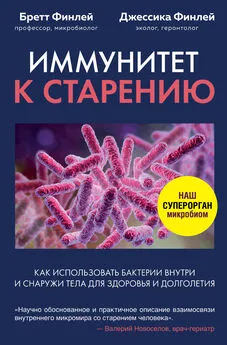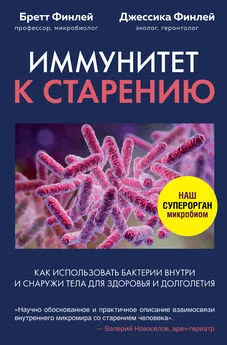Бретт Финлей - Иммунитет к старению. Как использовать бактерии внутри и снаружи тела для здоровья и долголетия
- Название:Иммунитет к старению. Как использовать бактерии внутри и снаружи тела для здоровья и долголетия
- Автор:
- Жанр:
- Издательство:ООО «Издательство «Эксмо»
- Год:2021
- Город:Москва
- ISBN:978-5-04-118241-0
- Рейтинг:
- Избранное:Добавить в избранное
-
Отзывы:
-
Ваша оценка:
Бретт Финлей - Иммунитет к старению. Как использовать бактерии внутри и снаружи тела для здоровья и долголетия краткое содержание
Иммунитет к старению. Как использовать бактерии внутри и снаружи тела для здоровья и долголетия - читать онлайн бесплатно ознакомительный отрывок
Интервал:
Закладка:
Jayasinghe, T. N., Chiavaroli, V., Holland, D. J., Cutfield, W. S., & O’Sullivan, J. M. (2016). The New Era of Treatment for Obesity and Metabolic Disorders: Evidence and Expectations for Gut Microbiome Transplantation. Frontiers in cellular and Infection Microbiology, 6(15). doi:10.3389/fcimb.2016.00015
Kong, F., Hua, Y., Zeng, B., Ning, R., Li, Y., & Zhao, J. (2016). Gut microbiota signatures of longevity. Current Biology: CB, 26(18), R832–R833. doi:10.1016/j. cub.2016.08.015
Konig, J., Siebenhaar, A., Hogenauer, C., Arkkila, P., Nieuwdorp, M., Noren, T., . Brummer, R. J. (2017). Consensus report: faecal microbiota transfer – clinical applications and procedures. Alimentary Pharmacology & Therapeutics, 45(2), 222–39. doi:10.1111/apt.13868
Leung, C., Rivera, L., Furness, J. B., & Angus, P. W. (2016). The role of the gut microbiota in NAFLD. Nature reviews. Gastroenterology & НАООСtology, 13(7), 412–25. doi:10.1038/nrgastro.2016.85
Maher, R. L., Hanlon, J., & Hajjar, E. R. (2014). Clinical consequences of polypharmacy in elderly. Expert Opinion on Drug Safety, 13(1), 57–65. doi:10.15 17/14740338.2013.827660
Santoro, A., Ostan, R., Candela, M., Biagi, E., Brigidi, P., Capri, M., & Franceschi, C. (2018). Gut microbiota changes in the extreme decades of human life: a focus on centenarians. Cellular and Molecular Life Sciences: CMLS, 75(1), 129–48. doi:10.1007/s00018-017–2674-y
Sonnenburg, E. D., Smits, S. A., Tikhonov, M., Higginbottom, S. K., Wingreen, N. S., & Sonnenburg, J. L. (2016). Diet-induced extinctions in the gut microbiota compound over generations. Nature, 529(7585), 212–15. doi:10.1038/nature16504
Suez, J., Korem, T., Zeevi, D., Zilberman-Schapira, G., Thaiss, C. A., Maza, O., . Elinav, E. (2014). Artificial sweeteners induce glucose intolerance by altering the gut microbiota. Nature, 514(7521), 181–86. doi:10.1038/nature13793
Thaiss, C. A., Itav, S., Rothschild, D., Meijer, M., Levy, M., Moresi, C., . Elinav, E. (2016). Persistent microbiome alterations modulate the rate of post-dieting weight regain. Nature, 540, 544–51. doi:10.1038/nature20796
Zeevi, D., Korem, T., Zmora, N., Israeli, D., Rothschild, D., Weinberger, A., . Segal, E. (2015). Personalized Nutrition by Prediction of Glycemic Responses. Cell, 163(5), 1079–94. doi:10.1016/j.cell.2015.11.001
American Heart Association. (2017). Good Fats and Bad Fats: The Facts on Healthy Fats. Retrieved from healthyforgood.heart.org/eat-smart/infographics/the-factson-fats
Bala, S., Marcos, M., Gattu, A., Catalano, D., & Szabo, G. (2014). Acute binge drinking increases serum endotoxin and bacterial DNA levels in healthy individuals. PloS One, 9(5), e96864. doi:10.1371/journal.pone.0096864
Chen, M. L., Yi, L., Zhang, Y., Zhou, X., Ran, L., Yang, J., . Mi, M. T. (2016). Resveratrol Attenuates Trimethylamine-N-Oxide (TMAO)-Induced Atherosclerosis by Regulating TMAO Synthesis and Bile Acid Metabolism via Remodeling of the Gut Microbiota. mBio, 7(2), e02210-02215. doi:10.1128/mBio.02210-15
Clarke, S. F., Murphy, E. F., O’Sullivan, O., Lucey, A. J., Humphreys, M., Hogan, A., . Cotter, P. D. (2014). Exercise and associated dietary extremes impact on gut microbial diversity. Gut, 63(12), 1913–20. doi:10.1136/gutjnl-2013–306541
Gregory, J. C., Buffa, J. A., Org, E., Wang, Z., Levison, B. S., Zhu, W., . Hazen, S. L. (2015). Transmission of atherosclerosis susceptibility with gut microbial transplantation. The Journal of Biological Chemistry, 290(9), 5647–60. doi:10.1074/jbc.M114.618249
Koeth, R. A., Wang, Z., Levison, B. S., Buffa, J. A., Org, E., Sheehy, B. T., . Hazen, S. L. (2013). Intestinal microbiota metabolism of L-carnitine, a nutrient in red meat, promotes atherosclerosis. Nature Medicine, 19(5), 576–85. doi:10.1038/nm.3145
Teicholz, N. (2014). The Big Fat Surprise: Why Butter, Meat and Cheese Belong in a Healthy Diet. New York, NY: Simon & Schuster Paperbacks.
Wang, Z., Roberts, A. B., Buffa, J. A., Levison, B. S., Zhu, W., Org, E., . Hazen, S. L. (2015). Non-lethal Inhibition of Gut Microbial Trimethylamine Production for the Treatment of Atherosclerosis. Cell, 163(7), 1585–95. doi:10.1016/j. cell.2015.11.055
Zhu, W., Gregory, J. C., Org, E., Buffa, J. A., Gupta, N., Wang, Z., . Hazen, S. L. (2016). Gut Microbial Metabolite TMAO Enhances Platelet Hyperreactivity and Thrombosis Risk. Cell, 165(1), 111–24. doi:10.1016/j.cell.2016.02.011
Baker, J. M., Al-Nakkash, L., & Herbst-Kralovetz, M. M. (2017). Estrogen-gut microbiome axis: Physiological and clinical implications. Maturitas, 103, 45–53. doi:10.1016/j.maturitas.2017.06.025
Ma, B., Forney, L. J., & Ravel, J. (2012). Vaginal microbiome: rethinking health and disease. Annual Review of Microbiology, 66, 371–89. doi:10.1146/annurevmicro-092611–150157
Martin, D. H. (2012). The microbiota of the vagina and its influence on women’s health and disease. The American Journal of the Medical Sciences, 343(1), 2–9. doi:10.1097/MAJ.0b013e31823ea228
Muhleisen, A. L., & Herbst-Kralovetz, M. M. (2016). Menopause and the vaginal microbiome. Maturitas, 91, 42–50. doi:10.1016/j.maturitas.2016.05.015
Schroder, W., Sommer, H., Gladstone, B. P., Foschi, F., Hellman, J., Evengard, B., & Tacconelli, E. (2016). Gender differences in antibiotic prescribing in the community: a systematic review and meta-analysis. The Journal of Antimicrobial Chemotherapy, 71(7), 1800–1806. doi:10.1093/jac/dkw054
Schwenger, E. M., Tejani, A. M., & Loewen, P. S. (2015). Probiotics for preventing urinary tract infections in adults and children. The Cochrane Database of Systematic Reviews (12), CD008772. doi:10.1002/14651858.CD008772.pub2
Shen, J., Song, N., Williams, C. J., Brown, C. J., Yan, Z., Xu, C., & Forney, L. J. (2016). Effects of low dose estrogen therapy on the vaginal microbiomes of women with atrophic vaginitis. Scientific Reports, 6(24380). doi:10.1038/srep24380
Thomas-White, K., Brady, M., Wolfe, A. J., & Mueller, E. R. (2016). The bladder is not sterile: History and current discoveries on the urinary microbiome. Current Bladder Dysfunction Reports, 11(1), 18–24. doi:10.1007/s11884-016–0345-8
Younes, J. A., Lievens, E., Hummelen, R., van der Westen, R., Reid, G., & Petrova, M. I. (2018). Women and Their Microbes: The Unexpected Friendship. Trends in Microbiology, 26(1), 16–32. doi:10.1016/j.tim.2017.07.008
Bacchus, C. M., Dunfield, L., Gorber, S. C., Holmes, N. M., Birtwhistle, R., Dickinson, J. A., . Tonelli, M. (2016). Recommendations on screening for colorectal cancer in primary care. CMAJ: Canadian Medical Association journal = journal de l’Association medicale canadienne, 188(5), 340–48. doi:10.1503/cmaj.151125
Cao, Y., Wu, K., Mehta, R., Drew, D. A., Song, M., Lochhead, P., . Chan, A. T. (2018). Long-term use of antibiotics and risk of colorectal adenoma. Gut, 67(4), 672–78. doi:10.1136/gutjnl-2016–313413
Garrett, W. S. (2015). Cancer and the microbiota. Science, 348(6230), 80–86. doi:10.1126/science.aaa4972
Gopalakrishnan, V., Spencer, C. N., Nezi, L., Reuben, A., Andrews, M. C., Karpinets, T. V., . Wargo, J. A. (2018). Gut microbiome modulates response to anti-PD-1 immunotherapy in melanoma patients. Science, 359(6371), 97–103. doi:10.1126/ science.aan4236
Hullar, M. A., Burnett-Hartman, A. N., & Lampe, J. W. (2014). Gut microbes, diet, and cancer. Cancer Treatment and Research, 159, 377–99. doi:10.1007/978–3-642–38007-5_22
Kostic, A. D., Chun, E., Robertson, L., Glickman, J. N., Gallini, C. A., Michaud, M., . Garrett, W. S. (2013). Fusobacterium nucleatum potentiates intestinal tumorigenesis and modulates the tumor-immune microenvironment. Cell Host & Microbe, 14(2), 207–15. doi:10.1016/j.chom.2013.07.007
Routy, B., Le Chatelier, E., Derosa, L., Duong, C. P. M., Alou, M. T., Daillere, R., . Zitvogel, L. (2018). Gut microbiome influences efficacy of PD-1-based immunotherapy against epithelial tumors. Science, 359(6371), 91–97. doi:10.1126/science.aan3706
Roy, S., & Trinchieri, G. (2017). Microbiota: a key orchestrator of cancer therapy. Nature reviews. Cancer, 17(5), 271–85. doi:10.1038/nrc.2017.13
Shono, Y., Docampo, M. D., Peled, J. U., Perobelli, S. M., Velardi, E., Tsai, J. J., . Jenq, R. R. (2016). Increased GVHD-related mortality with broad-spectrum antibiotic use after allogeneic hematopoietic stem cell transplantation in human patients and mice. Science Translational Medicine, 8(339), 339ra371. doi:10.1126/ scitranslmed.aaf2311
Sivan, A., Corrales, L., Hubert, N., Williams, J. B., Aquino-Michaels, K., Earley, Z. M., . Gajewski, T. F. (2015). Commensal Bifidobacterium promotes antitumor immunity and facilitates anti-PD-L1 efficacy. Science, 350(6264), 1084–89. doi:10.1126/science.aac4255
Urbaniak, C., Gloor, G. B., Brackstone, M., Scott, L., Tangney, M., & Reid, G. (2016). The Microbiota of Breast Tissue and Its Association with Breast Cancer. Applied and Environmental Microbiology, 82(16), 5039–48. doi:10.1128/AEM.01235-16
Vetizou, M., Pitt, J. M., Daillere, R., Lepage, P., Waldschmitt, N., Flament, C., . Zitvogel, L. (2015). Anticancer immunotherapy by CTLA-4 blockade relies on the gut microbiota. Science, 350(6264), 1079–84. doi:10.1126/science.aad1329
Weber, D., Jenq, R. R., Peled, J. U., Taur, Y., Hiergeist, A., Koestler, J., . Holler, E. (2017). Microbiota Disruption Induced by Early Use of Broad-Spectrum Antibiotics Is an Independent Risk Factor of Outcome after Allogeneic Stem Cell Transplantation. Biology of Blood and Marrow Transplantation: Journal of the American Society for Blood and Marrow Transplantation, 23(5), 845–852. doi:10.1016/j.bbmt.2017.02.006
Yang, Y., Xia, Y., Chen, H., Hong, L., Feng, J., Yang, J., . Ma, Y. (2016). The effect of perioperative probiotics treatment for colorectal cancer: short-term outcomes of a randomized controlled trial. Oncotarget, 7(7), 8432–40. doi:10.18632/ oncotarget.7045
Zitvogel, L., Daillere, R., Roberti, M. P., Routy, B., & Kroemer, G. (2017). Anticancer effects of the microbiome and its products. Nature reviews. Microbiology, 15(8), 465–78. doi:10.1038/nrmicro.2017.44
Atarashi, K., Tanoue, T., Oshima, K., Suda, W., Nagano, Y., Nishikawa, H., . Honda, K. (2013). Treg induction by a rationally selected mixture of Clostridia strains from the human microbiota. Nature, 500(7461), 232–36. doi:10.1038/nature12331
Berer, K., Gerdes, L. A., Cekanaviciute, E., Jia, X., Xiao, L., Xia, Z., . Wekerle, H. (2017). Gut microbiota from multiple sclerosis patients enables spontaneous autoimmune encephalomyelitis in mice. Proceedings of the National Academy of Sciences of the United States of America, 114(40), 10719–24. doi:10.1073/ pnas.1711233114
Caballero, S., & Pamer, E. G. (2015). Microbiota-mediated inflammation and antimicrobial defense in the intestine. Annual Review of Immunology, 33, 227–56. doi:10.1146/annurev-immunol-032713–120238
Calder, P. C., Bosco, N., Bourdet-Sicard, R., Capuron, L., Delzenne, N., Dore, J., . Visioli, F. (2017). Health relevance of the modification of low-grade inflammation in ageing (inflammageing) and the role of nutrition. Ageing Research Reviews, 40, 95–119. doi:10.1016/j.arr.2017.09.001
Cekanaviciute, E., Yoo, B. B., Runia, T. F., Debelius, J. W., Singh, S., Nelson, C. A., . Baranzini, S. E. (2017). Gut bacteria from multiple sclerosis patients modulate human T cells and exacerbate symptoms in mouse models. Proceedings of the National Academy of Sciences of the United States of America, 114(40), 10713–18. doi:10.1073/pnas.1711235114
Читать дальшеИнтервал:
Закладка:



![Валерий Полунин - Методы Востока для здоровья. Как оставаться молодым и активным в 50, 70, 90 лет [=Живите долго! Рецепты Аюрведы для здоровья и долголетия]](/books/1055946/valerij-polunin-metody-vostoka-dlya-zdorovya-kak-o.webp)
![Тим Беркхед - Самая совершенная вещь на свете [Внутри и снаружи птичьего яйца]](/books/1069359/tim-berkhed-samaya-sovershennaya-vech-na-svete-vnutr.webp)



